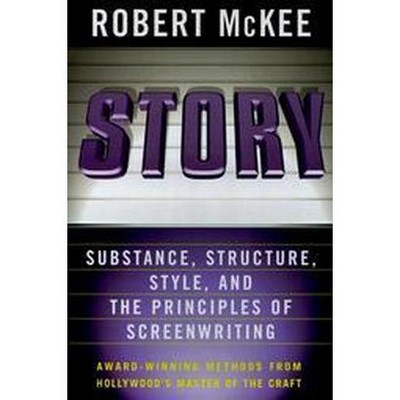I’ve had the good fortune to interview and work with many great storytellers over the last few years. What follows is a series of articles with hard-earned and learned lessons from some exceptional writers, storytellers, and teachers. One of those people was Robert McKee, the best-selling author of “STORY” and legendary guru of Hollywood storytelling, several years ago. The premise of the interview was simple – can the principles of his classic book “STORY” be used in the complex sales process?
SIMPLE CAN BE TIMELESS
Though the premise was simple, the lessons learned were timeless – and can be used in your life of business or the business of life.
WHO IS ROBERT MCKEE?
Robert McKee is the most widely known and respected screenwriting lecturer in the world today. His STORY Seminar has been taught to over 50,000 screenwriters, filmmakers, TV writers, novelists, industry executives, actors, producers, directors, and playwrights.
Teaching is easy. Results are hard. Robert McKee’s STORY and the stories delivered by his students have garnered;
- 32 Academy Awards – 106+ Nominations
- 168 Emmy Awards – 500+ Nominations
- 21 WGA Awards – 77+ Nominations
- 17 DGA Awards – 48+ Nominations
His former students’ accomplishments are unparalleled. Stories written, directed, or produced by students of Robert McKee include:
“Iron Man,” “Angels & Demons,” “WALL•E,” “Lord of the Rings I, II, III,” “A Beautiful Mind,” “Desperate Housewives”, “CSI, Law & Order,” “Cinderella Man”, “Gates of Fire” (novel), “The Daily Show,” Grey’s Anatomy,” “The Simpsons Movie,” “The DaVinci Code,” “Cars”,” Shrek.” “X-Men 3,” “Million Dollar Baby,” “Ratatouille”,”Finding Nemo,” “Paul Blart: Mall Cop,” “The Last Mimzy,” “Bobby,” “Quantum of Solace,” “The Color Purple,” “Crimson Tide,” “The Deer Hunter,” “The Elephant Man,” “ER,” “Forrest Gump,” “Gandhi,” “M*A*S*H,” “On Golden Pond,” “Saving Private Ryan,” “Robin Hood: Prince of Thieves,” “Sleepless in Seattle,” “The X-Files,” “A Time to Kill,” “Toy Story I and II,” and more.
Robert McKee knows STORY. He wrote the book.

INTERVIEW
Steve (S): How can the principles of Story work in the Complex-Sales presentation? How can it be used to resonate and touch disparate groups with different agendas, goals, and prejudices, while at the same time, connecting the intellect – making good economic business sense?
R: First, why is it so complex?
S: Good question … the complexity of the products and services and the buying committees have forced salespeople to communicate with a lot of different types and groups of people – users, business types, programmers, etc. To accomplish this, it usually turns into a 58-slide PowerPoint presentation laden with meaningless corporate acronyms to address every aspect of the individual’s wants/needs on the buyer’s committee … too much info.
And, the fact of the matter is, there are a lot of products and services that can solve their problems. There’s not a lot of difference. The key should be the sales presentation … effectively communicating simply the economic business value and connecting on an emotional level with the people.
R: You know, I’ve been in situations where writers are pitching their stories, right? They’re trying to sell their screenplay. Most executives are so busy that they would rather have the writer come in and pitch the story in 10 minutes before they decide whether they want to spend two or three hours reading it. So the pitch has to go well. I’ve seen writers come in and they’re charming, they’re funny, they do this brilliant song and dance about their story that they have obviously rehearsed and polished and then tell their story virtually tap dancing on your desk. And I have also had writers come in that were not very good. Not good! They were scared to death. They were very shy. They weren’t comfortable around people. They couch and choke their story out and … you know it’s brilliant.
S: But, how, or why, do you know the story is brilliant?
R: Because you listen to the story and no matter how badly the guy performs it, you go “that’s a great story.” You’re fascinated by the sudden story surprises and revelations – although the delivery may not be there.
LESSON LEARNED ONE: SMOOTH AND SLICK DON’T ALWAYS STICK
There’s hope for us less-than-smooth-and-slick storytellers and presenters. Great story rules. But you still need to work on your delivery.
S: What about the charming, funny guy?
R: Mr. Charm? You listen to his story and you know he’d better be charming because his story is a piece of crap if you actually listen to what’s being said. In the great play and the film Death of a Salesman, Willy Loman talked about always having a shine on your shoes and a smile on your face … but he’s a terrible salesman and his family is starving.
LESSON LEARNED TWO:
If you’re out to describe the truth – leave elegance to the tailor. – Albert Einstein
R: But I do know, presuming that the people you’re trying to persuade are intelligent and are actually listening and not being influenced by the charm of the speaker, that there’s a powerful, compelling way to present effectively. Story.
S: Story? Can you explain what you mean when you say that? How would you incorporate Story principles into the Complex-Sales presentation?
R: There are two choices or methods of presentation. Rhetoric or Story. It’s all about persuasion, right? You’re trying to persuade someone to buy something. Or in the Complex-Sales setting, you’re trying to persuade some people at various levels involved in the hierarchy of some organization. Rhetoric is the PowerPoint method where you present evidence in a particular order … or what is known as an inductive argument, right?
S: The difference?
R: Rhetoric is statistics, facts, quotes from authorities, etc. Rhetoric recites this point, this fact, this industry-analyst quote, and then another point, ad infinitum, so, therefore, mine is the best, the greatest, the one, the only, product and service that can do what you need.
S: Yes … so what’s wrong with that?
R: They know you’re lying! You lie in a rhetorical PowerPoint presentation by presenting the information in the most favorable light possible. The buyer knows you’re lying because the buyer is a businessperson who knows that nothing is that rosy. You quote your industry analysts – they’ll refute your industry analysts with theirs.
LESSON LEARNED THREE:
“I didn’t fib! I made a fable, like Aesop and those other guys.” – Dennis the Menace (noted philosopher I quote often)
Don’t lie … fabricate a fabulous fable.
R: Why expose your weaknesses? Why not conceal it? Because if you only give the positive side, they instinctively know you’re lying. Because why? Again, nothing is that good. The deep difference between presenting something rhetorically and creating it in a story… is that in a story, it is a dynamic of positive and negative charges.
S: Example?
R: You start up a business and immediately you’ve got problems. You overcome those problems and take a step forward, but new problems arise. You find ingenious ways to solve those problems only to discover that you have a competitor who’s got another product that does it better. You improve your product to be better than your competitor. It goes on. So when you tell a story, you can’t just hit positive, positive, positive.
In Story, you cannot hide the negative. It’s overcoming the negative that makes you powerful. It makes the positive even more positive in the eyes of the person whose hearing the story. Therefore, when you tell a story, admit problems and then dramatize the solution of those problems. Then cause new problems to arise. Dramatize the solution of those problems until you finally get to that positive climax. Because you’re admitting your negatives in front of them, it takes a lot of guts.
LESSON LEARNED FOUR:
Admit the negative. Overcome. Give yourself the power.
R: They sit there saying: “That’s right. That’s true. That’s what it’s like to be in a business environment. It’s not all positive. But this person is showing me how his product or his service will overcome those problems and how I will benefit.” As a result, they feel that they’re being told the truth.
S: But couldn’t you be lying anyway?
R: Yes, you can lie in a story just as well. But when you tell stories, if you lie, the lies become evident quickly because of the interweaving of story and fact. When you tell it in PowerPoint, they know you’re lying. They just don’t know where. There’s a more important lesson here. You realize, well, that’s a lie! That’s crap. I wouldn’t buy that.
LESSONS LEARNED FIVE:
“The truth is rarely pure, and never simple.” – Oscar Wilde
R: Preparing to tell your business case in a story forces you to confront the lie and search for the truth. You will catch yourself as you prepare for the presentation sloughing over certain problematic things. If you’ve got guts, you won’t slough over them. You will admit them.
S: Why? (Am I the master of the one-word question or what?)
R: Because then you will show how even these challenging problems are overcome. When you tell your story honestly, and you don’t hide the negative, you tell it well. People sit there with their mouths open going, “my God, what guts.” Put them in the position to see how the negative is overcome. You’ll gain their trust. And, you will have also impressed the heck out of them because you’re an honest human being who knows the reality. A person who deals in reality, but has honestly dramatized the way in which these problems, that we all, as business people, know exist.
LESSON LEARNED SIX:
Impress them with your honesty. Expose the negatives. Gain their trust.
S: In STORY, you say Paddy Chayefsky told you once that when he’d discovered his story’s meaning, he’d scratch it out on a scrap of paper and tape it to his typewriter so that nothing going through his typewriter would in one way or another express his central theme. A clear statement of Value and Cause. That seems like a logical first step in any story.
LESSON LEARNED SEVEN:
Discover your story’s meaning. Make it your clear statement of Value and Cause.
R: Yes. From there you’d take that same rhetorical presentation and dramatize it. Within the story there is rhetoric, there is information. The facts get woven into the story. Weave the information dramatically within a story. Leave them hanging. If you tell them a story that’s predictable, they’ll get ahead of you and lose interest. Tell a story that pits expectations vs. realities, and the struggles to overcome them. I believe great salespeople are by instinct, storytellers.
LESSON LEARNED EIGHT:
Pit expectations vs. realities. Tell the struggle to overcome. Leave them hanging.
S: And the foundation of a good storytelling Complex-Sales presentation is?
R: Research. The key to winning the war is research, taking time and effort to acquire knowledge. Understanding their problems …
S: Is that what you mean when you describe it as “storytelling from the inside out?”
R: Yes. You want them empathizing; you want them saying, “my God he’s telling my story. That’s me.” It’s got to be very personal for them.
LESSON LEARNED NINE:
Understand THEIR problems. Make it personal to them.
S: Could you talk a little about “The Principle of Creative Limitation?”
R: It’s exactly the subject we’re talking about. The PowerPoint presentation is easy, that’s why people do it. Creative limitation means instead of doing something the easy way; you do it the hard way. You take a method that is much more difficult to accomplish. As a result of your struggle as a salesman to accomplish the presentation in the form of a story, you are forcing yourself to be creative. The more difficult you make it for yourself, the more brilliant the solutions you will have to come up with, or you fail. And when you come up with brilliant creative solutions to the presentation, the results for the people, for the audience, are stunning.
LESSON LEARNED TEN:
Make it hard. Force yourself to be creative. It will stun your audience.
R: The principle of creative limitation forces you to do it the hard way. Story is more difficult than PowerPoint there is no question. You have to have a real talent for this, and you have to do it well, or you will look like a fool. That is why people avoid it because they don’t have the talent, they don’t do the research. They don’t know, they don’t know how to present it in a living way it’s difficult.
Why is whistling not a Beethoven symphony? Because whistling is easy. A Beethoven symphony is hard. But when you take on the challenge of writing a symphony, the creative solutions are amazing, overwhelming. Whistling is something you can do on the street.
The more difficult the technique, the more brilliant the solution. Another analogy … golf is more difficult than ping-pong. It’s not that ping-pong isn’t good, it’s a lot of fun and at the highest levels, it’s wonderful. But ping-pongers are not Tiger Woods, why? Because the golf swing is infinitely more difficult than hitting a ping-pong ball. Touch football is not tackle.
When you make things easy, the results are boring. When you make things difficult the creative solutions, the concentration, the practice, and the work that has to go into it, forces you to be creative. The results are all the more stunning. PowerPoints, of course, are the natural choice because people do not want to work and they don’t want to fail. And so they take what is easy and they think it will be successful. And then, they don’t get the sales.
LESSON LEARNED ELEVEN:
Challenge yourself. Do you want to be a whistler … or a Beethoven?
R: And so, when they fail, they blame the product, they blame the buyer for whatever reasons they rationalize they’re crazy.
S: In your book, you talk about the “GAP” … what is it, and could this be an effective tool in a Complex-Sales presentation?
R: The world does not react the way you thought it would react. The GAP is between expectation and reality. What do you do? You’ve got to gather yourself and find another solution. When the gap opens up in life, it’s because the negative side of life that you could not anticipate suddenly erupted in the face of your action. Every day you walk into an office expecting cooperation and then one day you get antagonism. The deep difference between Story and PowerPoint is that Story admits to the negative. Admits to the fact that life does not react the way you expect and that is a fundamental difference. The gap is the essence of overcoming the chasm between expectations and reality. PowerPoints, pretend that gaps don’t exist. PowerPoints, pretend that the world will react exactly the way you predict.
But what guides you, of course, is that you’re ultimately trying to leave with the buyer one, clear, simple idea you want them to all understand. Not just understand intellectually, but also understand emotionally by the time you’re done.
LESSON LEARNED TWELVE:
A good story connects one simple idea – intellectually and emotionally. It exposes, then overcomes the chasm between expectation and reality.
S: In your book, you said from the ’20s to the ’50s storytelling was common knowledge. Now it’s a lost art. Is Story really a lost art or is it just not being taught anymore?
R: We went through a terrible cycle of very, very bad education of the writer. Education of the writer/storyteller was turned inside out from the ’60s on, but now finally, the light is dawning on people and they see that there’s a difference. The fundamental difference is between criticism and creativity. What’s been taught to writers for the last 40 years was not creativity but criticism. The methods of speech and literature and writing at universities may have been extremely valuable to people who want to be critics, but useless to the writer/storyteller, and in fact, detrimental to the writer.
END OF INTERVIEW
For more information on STORY and the art of storytelling, visit Robert McKee website.


